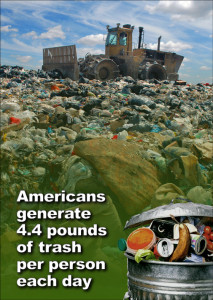3 Easy Ways to Improve Our Planet— and Your Pocketbook
Americans generate a shocking amount of trash— municipal solid waste (MSW) — 4.4 pounds per person every day!
 According to the Environmental Protection Agency (EPA), we create 251 million tons of MSW every year— most of which ends up in landfills.
According to the Environmental Protection Agency (EPA), we create 251 million tons of MSW every year— most of which ends up in landfills.
What Is Included in Municipal Solid Waste Estimates?
Basically, MSW is our everyday garbage. It consists mostly of:
• Batteries
• Bottles
• Broken appliances
• Cast-off furniture
• Discarded food scraps
• Disposable diapers and wipes
• Fast food containers
• Grass clippings
• Newspapers, magazines, and junk mail
• Paint
• Paper goods like papers towels, disposable diapers, paper plates, etc.
• Product packaging and containers
MSW figures do NOT contain industrial waste, construction and demolition (C&D) debris, wrecked cars, or hazardous materials.
Greed Breeds Garbage
Over the decades, Americans have gradually morphed into super-consumers. From 1975 to 2000, U.S. consumption of goods increased a monstrous 57%! According to EPA figures, the U.S. devours about 33% of the world’s total material consumption— yet Americans represent only 5% of the global population.
We buy more and more products, which all produce more and more garbage. The more we buy and discard, the greater the impact on our environment:
- Tropical forests are vanishing at a rate of one-acre-per-second.
- Since 1970, worldwide greenhouse gas emissions have skyrocketed 70%.
- Many experts believe increased greenhouse gas levels are attributing to global warming.
- Habitat destruction continues to cause the extinction of entire species.
- The accumulative effects of noxious, toxic chemicals are now found throughout the food chain.
Trimming the Trash
While all these wasteful facts are appalling, there is good news in the battle for a better environment.
Thirty years ago, the environmental movement consisted of a handful of green activists, labeled “tree huggers.” Today, eco-friendly practices have spread to mainstream America. More and more people are taking responsibility for their wasteful habits by taking action to clean up the planet.
American ingenuity in adversity is finding answers to trim the trash. Here is the good news in green issues:
- The amount of trash generated is down from 4.6 pounds to 4.4 pounds per person per day. That’s 73 pounds less per person per year.
- Landfill use is down.
- Recycling is up.
- Of the 251 million tons of MSW generated in the U.S. each year, 34.5% is now recycled or composted. According to EPA figures, that’s equivalent to removing the emissions spewed out by 33 million cars in a year!
- Technological advances in municipal solid waste handling has reduced the number of landfills, stretched landfill capacity, and reduced the emissions emanating from landfills.
How Can You Help Cut MSW?
The EPA recommends three ways we can all help in the fight against waste:
- PREVENTION: Consume less. Buy refillable containers. Buy only what you really need— especially in food items. Your budget will thank you— and so will future generations. Bring reusable canvas bags with you when you shop.
- RECYCLING: Think twice about the goods you buy— and how those goods are packaged. Choose environmentally friendly and biodegradable products and with recycled packaging. Recycle paper, cans, plastics, and glass, instead of dumping them into your garbage.
- COMPOSTING: Take organic material like yard trimmings and food scraps and compost them. Once they breakdown, they create a rich natural fertilizer. According to the EPA, more than 95% of food waste that could be composted ends up in landfills or incinerators.
Think Lifecycle
Green-thinking people consider all aspects of green products, looking at the material’s entire lifecycle. Is it sustainable? Is it durable? Will it wind up in a landfill at the end of its usefulness?
That is why environmental-conscious people choose pre-engineered steel buildings for low-rise projects.
- Steel is sustainable and 100% recyclable.
- Structural steel contains an extremely high-recycled content. RHINO metal building components contain as much as 90.7% recycled steel.
- Unlike other recycled materials, steel retains ALL its strength— regardless of how many times it is recycled. Steel buildings are extremely durable, lasting far longer than other building systems.
- The strength of steel means less material is needed to create a much stronger structure.
- At the end of a steel structure’s lifecycle, all the framing and cladding can be sold to a metal scrap dealer to be recycled again.
Want to know more about the green attributes of RHINO’s red-iron steel buildings? Call RHINO now at 940.383.9566. Speak to one of our friendly, experienced metal building specialists today about making your next project a green project with RHINO Steel Building Systems.
